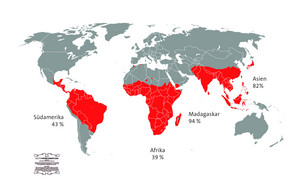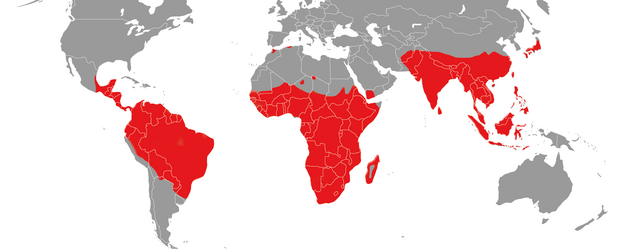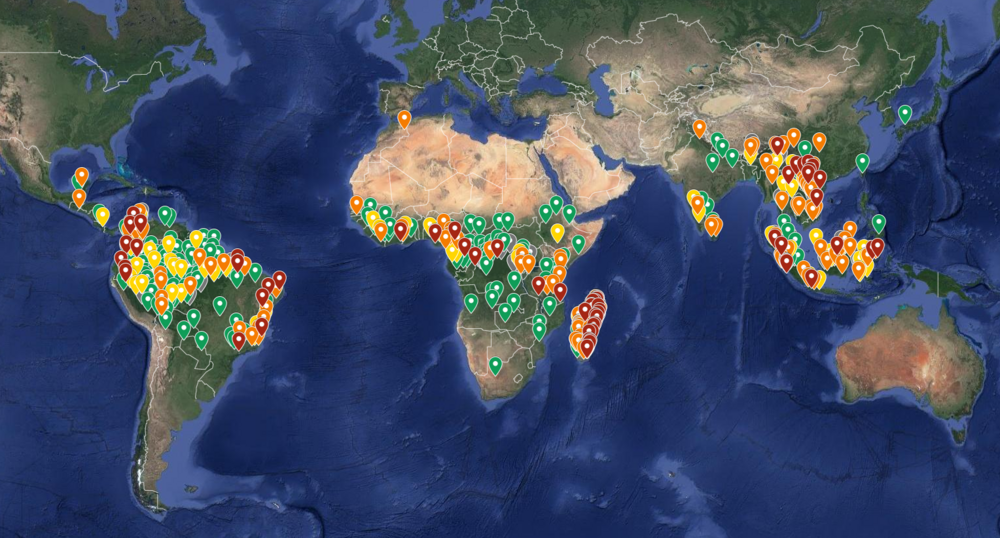![Favela Rocinha in Rio de Janeiro. Photo: chensiyuan, CC BY-SA 4.0-3.0-2.5-2.0-1.0 (http://creativecommons. org/licenses/by-sa/4.0-3.0-2.5-2.0-1.0)], via Wikimedia Commons](/fileadmin/_processed_/f/2/csm_Favela_c49063600c.jpg)
Species extinction is a natural process that constantly occurs. However, the speed with which animal and plant species are becoming extinct nowadays is far above the normal level. Such a phenomenon is called mass extinction and similar periods have always occurred in the past. A similar mass extinction occurred 65 million years when almost all of the dinosaurs fell victim to it. While this was previously due to natural disasters (asteroid impacts, climate change), today's mass extinction is mainly blamed on humans. The explosive human population increase and the accompanying overuse of natural resources mean that many species are deprived of their livelihood (Kolbert 2015). Non-human primates are affected since they live in regions where population growth is particularly high and characterized by political instability and poverty (Estrada et al. 2017).
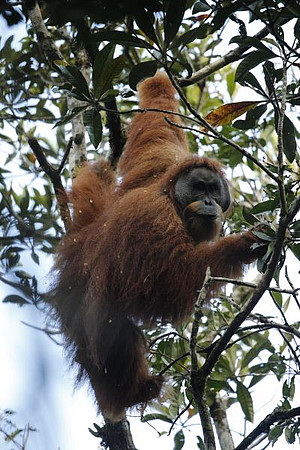
The International Union for the Conservation of Nature (IUCN) evaluates the available data on as many plant and animal species as possible for their "Red List of Endangered Species". Two-thirds of the approximately 500 known non-human primate species have so far been evaluated. Of these, 62 percent had to be classified as threatened. Approximately 14 percent are even considered to be directly threatened with extinction. 94 percent of the lemurs in Madagascar are threatened and almost a quarter is close to extinction. 82 percent of all Asian primates are threatened with extinction and that includes the three orangutan species. All apes – with the exception of humans – are threatened. The gorillas and chimpanzees of Africa as well as the gibbons of South and Southeast Asia are listed as critically endangered or threatened with extinction on the Red List (IUCN 2016). Officially, no species has become extinct in the last 100 years. However, Miss Waldron's colobus (Piliocolobus waldronae) have not been sighted for 20 years and the population of the Hainan black crested gibbons (Nomascus hainanus) amounts to just 30 individuals.

https://commons.wikimedia.org/w/index.php?curid=1899947
The primary threat for most primate populations is the destruction of their natural habitat. This is mainly converted into agricultural land for the cultivation of crops or pasture for livestock. If the primates live in a relatively small enclosed area, as is the case with many lemurs on Madagascar the deforestation of a single forest is often sufficient to cause distress. It is not always the need for food in the countries of origin, but the needs of the developed countries to buy cheap palm oil and soy-based animal food. In addition, many tropical forests are cut down for the production of exotic wood and useful timber. Despite growing awareness, wood from the tropics is still a much sought-after material, for example for patio floors and furniture.

In addition to the economic exploitation of their habitat, direct hunting is also a reason for declining primate numbers. In many poor countries devastated by civil wars, wildlife is often the only protein source and forests therefore pay the price. In the Democratic Republic of the Congo, the population of the eastern lowland gorillas (Gorilla beringei graueri) declined by 77 percent in just one generation.
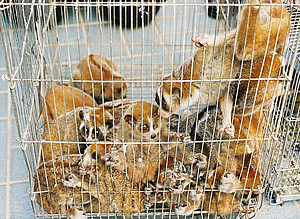
But even in emerging countries, such as Brazil, hunting for primates is still high up on the list. As a result, the depletion of mineral resources and the associated development of remote regions, inevitably lead to the decrease of wild animals in the area. Trading primates as pets is still a lucrative business and in many Southeast Asian areas, primate products are used as traditional medicine (Sweater et al. 2017). The threat factors are manifold and there will be no easy solution to the problem of dwindling primate populations. It is clear that it is not exclusively a problem of the regions of origin and that the industrialized countries also have to worry about the protection of our closest biological relatives (Estrada et al., 2017).
Literature
Kolbert E (2015): Das Sechste Sterben: Wie der Mensch Naturgeschichte schreibt. Berlin, Suhrkamp.
Estrada A, Garber PA, Rylands AB, Roos C, Fernandez-Duque E, Di Fiore A, Nekaris KA-I, Nijman V, Heymann EW, Lambert JE, Rovero F, Barelli C, Setchell JM, Gillespie TR,l Mittermeier RA, Verde Arregoitia L, de Guinea M, Gouveia S, Dobrovolski R, Shanee S, Shanee N, Boyle SA, Fuentes A, MacKinnon KC, Amato KR, Meyer ALS, Wich S, Sussman RW, Pan R, Kone I, Li B (2017): Impending extinction crisis of the world’s primates: Why primate matter. Science Advances 3: e1600946.
International Union for Conservation of Nature (2016): IUCN Red List of Threatened Species. Version 2015-4. Frei verfügbar unter: http://www.iucnredlist.org/
Schwitzer C, Mittermeier RA, Rylands AB, Chiozza F, Williamson EA, Wallis J, Cotton A (2017): Primates in Peril: The World’s 25 Most Endangered Primates 2016-2018. IUCN SSC Primate Specialist Group (PSG), International Primatological Society (IPS), Conservation International (CI), and Bristol Zoological Society, Arlington. Frei verfügbar unter: http://www.primate-sg.org/
Further information
International Union for Conservation of Nature (IUCN)
Red List of Threatened Species
Distribution and threat of primates
